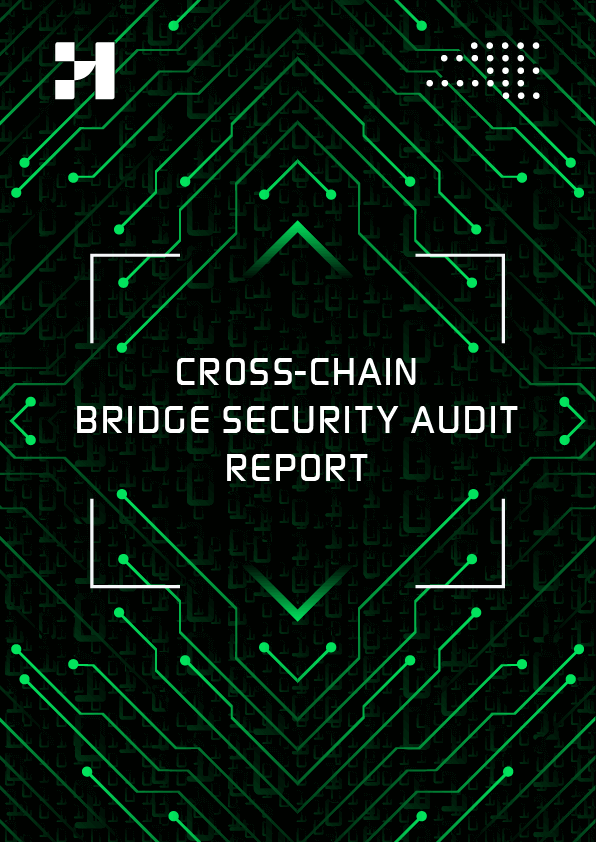Cross-Chain Bridge Audit
Get seamless security against hacking and exploitation with the industry’s first and only AI-powered company, thanks to Hackdra’s Cross-Chain Bridge audit.
Why Cross-Chain Bridge Audit
Build trust and minimize risks with Cross-Chain Bridge auditing
Cross-chain bridge auditing is a meticulous process that ensures the security and reliability of blockchain interoperability. By subjecting the bridge to comprehensive audits, potential vulnerabilities, exploits, and weaknesses can be identified and addressed, bolstering the overall security posture of the interoperability solution. Projects that have undergone and successfully completed the audit earn a place in the Hackdra Web3 Security Scoreboard, signifying their dedication to security and providing a strong indication to the entire Web3 community of their commitment to safeguarding users’ assets during cross-chain transactions.
Avoid costly errors
Optimize your code
Increase audience trust
What projects need a Cross-Chain Bridge audit?
A Cross-Chain Bridge Audit is a process that audits the security of software or protocols that transfer assets between different blockchains. These audits aim to protect users’ assets by identifying vulnerabilities. A secure Cross-Chain Bridge allows users to safely transfer assets and is a fundamental requirement in the cryptocurrency world.
NFT Platforms
DeFi Protocols
Decentralized Exchanges (DEX)
Gaming Platforms
When does a project need a Cross-Chain Bridge audit?
A project that enables the transfer of assets between different blockchains needs a Cross-Chain Bridge audit. This audit ensures that the project operates in a secure and reliable manner. In addition, a Cross-Chain Bridge audit may be needed when the volume of asset transfers increases, to adapt to changing security standards, when new blockchains are integrated, or in response to community requests. These audits are important to ensure the security of the project and the protection of users’ assets.
When a new Cross-Chain Bridge is developed
When the volume of asset transfer increases
To adapt to changing security standards
When new integrations are made
In response to community requests
Benefits of cross-chain bridge auditing by Hackdra
Cross-Chain Bridge auditing, together with the service offered by Hackdra, offers significant benefits to ensure the integrity and security of your project, minimizing risks and maximizing success.
Enhanced Security
Trust and Reputation
Regulatory Compliance
Expertise and Experience
Timely and Efficient Process
Transparent Pricing
Ongoing Support
Customized Solutions
Cross-Chain Bridge Audit Process
The Cross-Chain Bridge Audit Process involves a thorough examination of the bridge’s codebase, smart contracts, and security measures. It aims to ensure the reliability and safety of asset transfers between different blockchains. The process includes planning, code review, smart contract evaluation, testing, security assessment, detailed reporting, and implementation of recommended improvements to enhance the bridge’s security.
Planning
Code Review
Smart Contract Audit
Testing Phase
Security Assessment
Reporting
Implementation and Improvement
Certification and Publication on OZNET
What does a Cross-Chain Bridge audit report include?

Detailed classification of identified security vulnerabilities according to their importance levels,
Step-by-step recommendations on how to resolve security vulnerabilities,
Suggestions for performance improvement for future development potential,
Scoring of documentation quality, code quality, architectural quality, and security elements.
FAQ
Ask Us a Question
If you have any questions about Cross-Chain Bridge Audit, please first check the FAQ section. If you still can’t find an answer, feel free to contact us or ask your question quickly. We are happy to assist you.
Cross-Chain Bridge is a technology that enables asset transfers between different blockchains.
The security of Cross-Chain Bridge is ensured through cryptographic protocols and smart contracts.
Cross-Chain Bridge generally allows asset transfers between popular blockchains such as Ethereum, Binance Smart Chain, and Polygon.
It generally supports popular wallets such as MetaMask, Trust Wallet, and Ledger.
Yes, using Cross-Chain Bridge generally requires a transaction fee.
The transaction time can vary depending on the speed of the blockchains involved, but it generally ranges from a few minutes to a few hours.
Basic security measures such as securing private keys, using correct addresses, and obtaining information from reliable sources should be taken into account.
Generally, basic technical knowledge is sufficient for using Cross-Chain Bridge, but in some cases, more advanced knowledge may be required.
In some cases, there may be limitations for certain types or amounts of assets.
With the development of Cross-Chain Bridge technology, we can expect more blockchain integrations, faster transaction times, and lower fees.